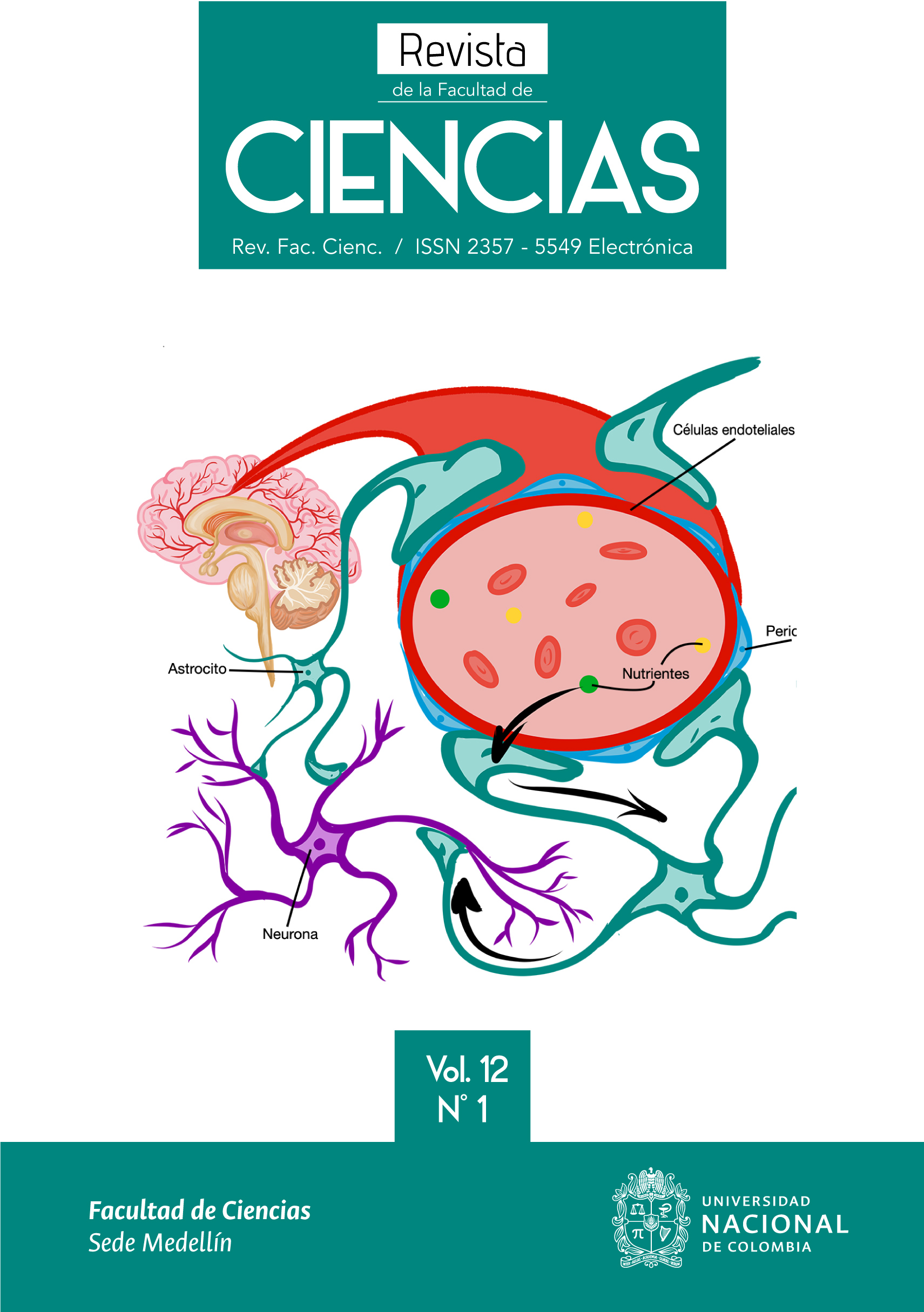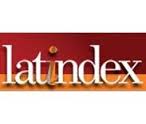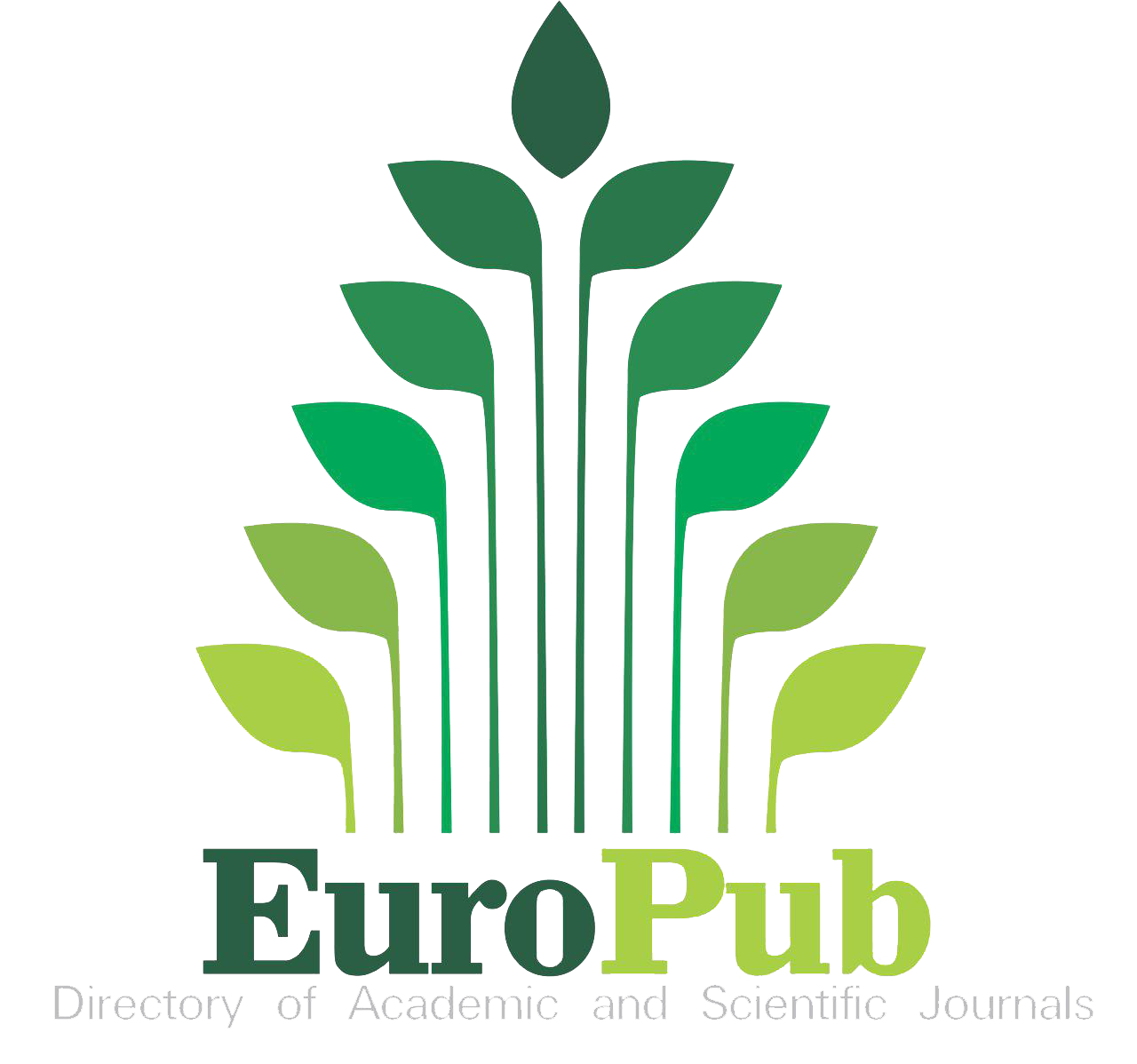REVISIÓN, CARACTERIZACIÓN Y ANÁLISIS BIOINFORMÁTICO DE NUEVA DELHI METALO-β-LACTAMASA-1 (NDM-1) Y SUS VARIANTES
REVIEW, CHARACTERIZATION AND BIOINFORMATIC ANALYSIS OF NEW DELHI METALLO-ß-LACTAMASA-1 (NDM-1) AND ITS VARIANTS
DOI:
https://doi.org/10.15446/rev.fac.cienc.v12n1.104338Palabras clave:
PDB, PsiPred, SWISS-MODEL, NDM-1 (es)NDM-1, PDB, SWISS-MODEL, PsiPred (en)
Descargas
Tanto la enzima NDM-1, como sus variantes reportadas, presentan multiresistencia a distintos antibióticos para el tratamiento de patologías de tipo infeccioso. El presente trabajo muestra una revisión del mecanismo hidrolítico que sigue la enzima, un análisis bioinformático de la NDM-1 a NDM-16, algunas características genéticas, mutaciones y estudio del sitio activo. Se encontró que las 16 variantes presentan 14 mutaciones, utilizando como plantilla, la secuencia aminoacídica de NDM-1; además se establece la posibilidad de tomar estructuras de medicamentos como D-captopril para diseñar prototipos de mayor actividad y biodisponibilidad, así como baja toxicidad.
Both the NDM-1 enzyme and its reported variants present multiresistance to different antibiotics for the treatment of infectious diseases. The present work shows a revision of the hydrolytic mechanism that the enzyme follows, a bioinformatic analysis of NDM-1 to NDM-16, some genetic characteristics, mutations and study of the active site. It was found that the 16 variants present 14 mutations, using as a template, the aminoacidic sequence of NDM-1; It also establishes the possibility of taking drug structures such as D-captopril to design prototypes with greater activity and bioavailability, as well as low toxicity.
Referencias
Abarca, G., & Herrera, M. L. (2001). Betalactamasas: su importancia en la clínica y su detección en el laboratorio. Revista Médica del Hospital Nacional de Niños Dr. Carlos Sáenz Herrera, 36, 77-104.
Abhinav, K., & Jaiswal, A. (2013). NDM-1-New Delhi Metallo beta Lactamase: A Review. Angewandten Biologie Forschung, 1, 1.
Ackerman, S. H., & Gatti, D. L. (2013). Biapenem inactivation by B2 metallo β-lactamases: energy landscape of the hydrolysis reaction. PloS one, 8, e55136. DOI: https://doi.org/10.1371/journal.pone.0055136
Alcaide, B., de Murga, R. M., Pardo, C., & Rodríguez-Ranera, C. (2004). Access to enantiopure polycyclic β-lactams by Diels–Alder reaction of novel inner-outer-ring 2-(silyloxy) dienes with a carbacepham skeleton. Tetrahedron letters, 45, 7255-7259. DOI: https://doi.org/10.1016/j.tetlet.2004.08.022
Ali, A., Kumar, R., Iquebal, M. A., Jaiswal, S., Kumar, D. & Khan, A. U. (2019). Role of conserved residues in catalytic activity of NDM-1: an approach of site directed mutagenesis and molecular dynamics. DOI: https://doi.org/10.1039/C9CP02734C
Ariza, B., & León, A. (2013). Carbapenemasa Nueva Delhi tipo 1 (NDM): Descripción fenotípica, epidemiológica y tratamiento. Laboratorio Actual, 44.
Bebrone, C. (2007). Metallo-β-lactamases (classification, activity, genetic organization, structure, zinc coordination) and their superfamily. Biochemical pharmacology, 74, 1686-1701. DOI: https://doi.org/10.1016/j.bcp.2007.05.021
Bebrone, C., Lassaux, P., Vercheval, L., Sohier, J. S., Jehaes, A., Sauvage, E., & Galleni, M. (2010). Current challenges in antimicrobial chemotherapy. Drugs, 70, 651-679. DOI: https://doi.org/10.2165/11318430-000000000-00000
Bush, K., & Jacoby, G. (2010). Updated functional classification of β-lactamases. Antimicrobial agents and chemotherapy, 54, 969-976. DOI: https://doi.org/10.1128/AAC.01009-09
Christopeit, T., & Leiros, H. K. S. (2016). Fragment-based discovery of inhibitor scaffolds targeting the metallo-β-lactamases NDM-1 and VIM-2. Bioorganic & Medicinal Chemistry Letters, 26, 1973-1977. DOI: https://doi.org/10.1016/j.bmcl.2016.03.004
Cortés, J. (2011). Resistencia en enterobacterias: evolución, enzimas y ambiente. Infectio, 15, 145-146. DOI: https://doi.org/10.1016/S0123-9392(11)70077-7
Cruz, E. & Ramón, G. (2010). Modelación molecular de antibióticos betalactámicos. Medisur, 8, 13-19.
Deshpande, P., Rodrigues, C., Shetty, A., Kapadia, F., Hedge, A., & Soman, R. (2010). New Delhi Metallo-beta lactamase (NDM-1) in Enterobacteriaceae: treatment options with carbapenems compromised. The Journal of the Association of Physicians of India, 58, 147-149.
Dortet, L., Poirel, L., & Nordmann, P. (2014). Worldwide dissemination of the NDM-type carbapenemases in Gram-negative bacteria. BioMed research international, 2014. DOI: https://doi.org/10.1155/2014/249856
Escalona, J.; Carrasco, R.; Padrón, J.(2008) Introducción al diseño racional de fármacos., Ciudad de La Habana., Editorial Universitaria., Ministerio de Educación Superior. 45p.
Ghafur, A. (2010). An obituary--on the death of antibiotics!. The Journal of the Association of Physicians of India, 58, 143-144.
Gonzalez et al., (2015), Caracterización fenotípica y genotípica de perfiles de resistencia antimicrobiana de aislamientos bacterianos recuperados en Infecciones Asociadas a la Atención en Salud (IAAS) septiembre 2012 - diciembre 2014. [En línea]. Instituto nacional de salud, Bogotá, Colombia. [Consultado en agosto de 2022]. Disponible en: https://www.ins.gov.co/buscador/Informacin%20de%20laboratorio/Informe%20Vigilancia%20por%20Laboratorio%20Resistencia%20Antimicrobiana%20IAAS%202012-2014.pdf
Gordon, E., Mouz, N., Duee, E., & Dideberg, O. (2000). The crystal structure of the penicillin-binding protein 2x from Streptococcus pneumoniae and its acyl-enzyme form: implication in drug resistance. Journal of molecular biology, 299, 477-485. DOI: https://doi.org/10.1006/jmbi.2000.3740
Guo, Y., Wang, J., Niu, G., Shui, W., Sun, Y., Zhou, H., ... & Rao, Z. (2011). A structural view of the antibiotic degradation enzyme NDM-1 from a superbug. Protein & cell, 2, 384-394. DOI: https://doi.org/10.1007/s13238-011-1055-9
Hall, B. G., Salipante, S. J., & Barlow, M. (2003). The metallo-β-lactamases fall into two distinct phylogenetic groups. Journal of molecular evolution, 57, 249-254. DOI: https://doi.org/10.1007/s00239-003-2471-0
Islam, N. U. (2013). An update on the status of potent inhibitors of metallo-β-lactamases. Scientia pharmaceutica, 81, 309-328. DOI: https://doi.org/10.3797/scipharm.1302-08
Kim, Y., Cunningham, M. A., Mire, J., Tesar, C., Sacchettini, J., & Joachimiak, A. (2013). NDM‐1, the ultimate promiscuous enzyme: substrate recognition and catalytic mechanism. The FASEB Journal, 27, 1917-1927. DOI: https://doi.org/10.1096/fj.12-224014
Lee, N. L., Yuen, K. Y., & Kumana, C. R. (2001). β-Lactam antibiotic and β-lactamase inhibitor combinations. Jama, 285, 386-388. DOI: https://doi.org/10.1001/jama.285.4.386
Lesk, A. (2019). Introduction to bioinformatics. Oxford university press.
Liang, Z., Li, L., Wang, Y., Chen, L., Kong, X., Hong, Y., : : :, & Jiang, H. (2011). Molecular basis of NDM-1, a new antibiotic resistance determinant. PLoS One, 8, e23606. DOI: https://doi.org/10.1371/journal.pone.0023606
Liu, X. L., Shi, Y., Kang, J. S., Oelschlaeger, P., & Yang, K. W. (2015). Amino acid thioester derivatives: a highly promising scaffold for the development of metallo-β-lactamase L1 inhibitors. ACS medicinal chemistry letters, 6, 660-664. DOI: https://doi.org/10.1021/acsmedchemlett.5b00098
Ma, J., McLeod, S., MacCormack, K., Sriram, S., Gao, N., Breeze, A. L., & Hu, J. (2014). Real–Time Monitoring of New Delhi Metallo b–Lactamase Activity in Living Bacterial Cells by 1H NMR Spectroscopy. Angewandte Chemie International Edition, 8, 2130–2133. DOI: https://doi.org/10.1002/anie.201308636
Meini, M. R., Llarrull, L. I., & Vila, A. J. (2014). Evolution of metallo-β-lactamases: trends revealed by natural diversity and in vitro evolution. Antibiotics, 3, 285-316. DOI: https://doi.org/10.3390/antibiotics3030285
Moncada, M. (2014). Caracterización molecular de aislamientos de klebsiella pneumoniae portadores del genbla NDM-1 procedentes de una unidad neonatal en un hospital de Bogotá. Posgrado Interfacultades en Microbiología.
Morales-Moreno, Y., Medina-Marrero, R., Garcia-Bernal, M., Casanova-González, M., Rodríguez-Pérez, R., Fernández-López, N., ... & Rojas-Hernández, N. (2014). Actividad in vitro de furvina frente a bacterias Gram negativas multirresistentes. Revista CENIC. Ciencias Biológicas, 45, 052-057.
Murray, C. J., Ikuta, K. S., Sharara, F., Swetschinski, L., Aguilar, G. R., Gray, A., ... , & Naghavi, M. (2022). Global burden of bacterial antimicrobial resistance in 2019: a systematic analysis. The Lancet, 399, 629–655. DOI: https://doi.org/10.1016/S0140-6736(21)02724-0
OPS/OMS. (2014). Actualización Epidemiológica. Carbapenemasas tipo New Delhi metalobetalactamasas (NDM). [En línea]. [Consultado en agosto de 2022]. Disponible en: https://www.paho.org/hq/dmdocuments/2014/2014-mar-07-cha-carbapenemasas-actualizacion-epi.pdf
Ovalle M. et al. (2013). Vigilancia epidemiológica comunitaria en las entidades territoriales departamentales y distritales, Colombia, 2012, IQEN, 18, 111-120.
Papp-Wallace, K. M., Endimiani, A., Taracila, M. A., & Bonomo, R. A. (2011). Carbapenems: past, present, and future. Antimicrobial agents and chemotherapy, 55, 4943-4960. DOI: https://doi.org/10.1128/AAC.00296-11
Pathak, R. K., Singh, D. B. & Singh, R. (2022). Introduction to basics of bioinformatics. In Bioinformatics (pp. 1–15). Academic Press. DOI: https://doi.org/10.1016/B978-0-323-89775-4.00006-7
Pérez, M. (2009). Uso de técnicas separativas miniaturizadas como alternativa a la determinación de antibióticos beta-lactámicos en fármacos, aguas y alimentos.
Queenan, A., & Bush, K. (2007). Carbapenemases: the versatile β-lactamases. Clinical microbiology reviews, 20, 440-458. DOI: https://doi.org/10.1128/CMR.00001-07
Rahman, M.,& Khan, M. K. A. (2019). In silico based unraveling of New Delhi metallo-b-lactamase (NDM- 1) inhibitors from natural compounds: a molecular docking and molecular dynamics simulation study. Journal of Biomolecular Structure and Dynamics. DOI: https://doi.org/10.1080/07391102.2019.1627248
Rivière, G., Oueslati, S., Gayral, M., Créchet, J. B., Nhiri, N., Jacquet, E., ... & Morellet, N. (2020). NMR Characterization of the Influence of Zinc (II) Ions on the Structural and Dynamic Behavior of the New Delhi Metallo-Lactamase-1 and on the Binding with Flavonols as Inhibitors. omega, 5, 10466-10480. DOI: https://doi.org/10.1021/acsomega.0c00590
Rojas, S. Y. S., Duarte, C., de Arias, M. N. G. & Ovalle, M. V. (2017). Emergencia de Providencia rettgeri NDM-1 en dos departamentos de Colombia, 2012-2013. Enfermedades infecciosas y microbiología clínica, 35, 358–358. DOI: https://doi.org/10.1016/j.eimc.2015.05.011
Rolain, J. M., Parola, P., & Cornaglia, G. (2010). New Delhi metallo-beta-lactamase (NDM-1): towards a new pandemia? Clinical Microbiology and Infection, 16, 1699-1701. DOI: https://doi.org/10.1111/j.1469-0691.2010.03385.x
Salari-Jazi, A., Mahnam, K., Sadeghi, P., Damavandi, M. S., & Faghri, J. (2021). Discovery of potential inhibitors against New Delhi metallo-lactamase-1 from natural compounds: In silico-based methods. Scientific reports, 11, 1–20. DOI: https://doi.org/10.1038/s41598-021-82009-6
Shen, B., Yu, Y., Chen, H., Cao, X., Lao, X., Fang, Y., ... & Zheng, H. (2013). Inhibitor discovery of full-length New Delhi metallo-β-lactamase-1 (NDM-1).PloS one, 8, e62955. DOI: https://doi.org/10.1371/journal.pone.0062955
Skagseth, S., Akhter, S., Paulsen, M. H., Muhammad, Z., Lauksund, S., Samuelsen, Ø., ... & Bayer, A. (2017). Metallo-β-lactamase inhibitors by bioisosteric replacement: Preparation, activity and binding. European journal of medicinal chemistry, 135, 159-173. DOI: https://doi.org/10.1016/j.ejmech.2017.04.035
Strynadka, N. C., Adachi, H., Jensen, S. E., Johns, K., Sielecki, A., Betzel, C., : : : & James, M. N. (1992). Molecular structure of the acyl-enzyme intermediate in b-lactam hydrolysis at 1.7 Å resolution. Nature, 359, 700–705. DOI: https://doi.org/10.1038/359700a0
Suárez, C., & Gudiol, F. (2009). Antibióticos betalactámicos. Enfermedades infecciosas y microbiología clínica, 27, 116-129. DOI: https://doi.org/10.1016/j.eimc.2008.12.001
Suárez, C. J., Kattán, J. N., GUZMÁN, A., & Villegas, M. V. (2006). Mecanismos de resistencia a carbapenems en P. aeruginosa, Acinetobacter y Enterobacteriaceae y estrategias para su prevención y control. Infectio, 10, 85-93.
Valencia, E. (2014). Diseño racional de compuestos espirotiazolidónicos, pirazolotiazolidónicos y pirazolo ß-lactámicos con potencial actividad antimicrobiana. Departamento de Química.
Vignoli, R., & Seija, V. (2006). Principales mecanismos de resistencia antibiótica. Temas de bacteriología y Virología. Instituto de Higiene, 649-662.
Walsh, T. R., Toleman, M. A., Poirel, L. & Nordmann, P. (2005). Metallo-b-lactamases: the quiet before the storm?. Clinical microbiology reviews, 18, 306–325. DOI: https://doi.org/10.1128/CMR.18.2.306-325.2005
Yacoby, I., & Benhar, I. (2007). Targeted anti bacterial therapy. Infectious Disorders-Drug Targets (Formerly Current Drug Targets-Infectious Disorders), 7, 221-229. DOI: https://doi.org/10.2174/187152607782109998
Yang, S. K., Kang, J. S., Oelschlaeger, P., & Yang, K. W. (2015). Azolylthioacetamide: a highly promising scaffold for the development of metallo-β-lactamase inhibitors. ACS medicinal chemistry letters, 6, 455-460. DOI: https://doi.org/10.1021/ml500534c
Yong, D., Toleman, M. A., Giske, C. G., Cho, H. S., Sundman, K., Lee, K., & Walsh, T. R. (2009). Characterization of a new metallo-β-lactamase gene, bla NDM-1, and a novel erythromycin esterase gene carried on a unique genetic structure in Klebsiella pneumoniae sequence type 14 from India. Antimicrobial agents and chemotherapy, 53, 5046-5054. DOI: https://doi.org/10.1128/AAC.00774-09
Zapun, A., Contreras-Martel, C., & Vernet, T. (2008). Penicillin-binding proteins and β-lactam resistance. FEMS microbiology reviews, 32, 361-385. DOI: https://doi.org/10.1111/j.1574-6976.2007.00095.x
Zhang, Y. L., Yang, K. W., Zhou, Y. J., LaCuran, A. E., Oelschlaeger, P., & Crowder, M. W. (2014). Diaryl‐substituted azolylthioacetamides: inhibitor discovery of New Delhi Metallo‐β‐Lactamase‐1 (NDM‐1). ChemMedChem, 9, 2445-2448. DOI: https://doi.org/10.1002/cmdc.201402249
Cómo citar
APA
ACM
ACS
ABNT
Chicago
Harvard
IEEE
MLA
Turabian
Vancouver
Descargar cita
Licencia
Derechos de autor 2023 Revista de la Facultad de Ciencias

Esta obra está bajo una licencia internacional Creative Commons Atribución-NoComercial-SinDerivadas 4.0.
Los autores o titulares del derecho de autor de cada artículo confieren a la Revista de la Facultad de Ciencias de la Universidad Nacional de Colombia una autorización no exclusiva, limitada y gratuita sobre el artículo que una vez evaluado y aprobado se envía para su posterior publicación ajustándose a las siguientes características:
1. Se remite la versión corregida de acuerdo con las sugerencias de los evaluadores y se aclara que el artículo mencionado se trata de un documento inédito sobre el que se tienen los derechos que se autorizan y se asume total responsabilidad por el contenido de su obra ante la Revista de la Facultad de Ciencias, la Universidad Nacional de Colombia y ante terceros.
2. La autorización conferida a la revista estará vigente a partir de la fecha en que se incluye en el volumen y número respectivo de la Revista de la Facultad de Ciencias en el Sistema Open Journal Systems y en la página principal de la revista (https://revistas.unal.edu.co/index.php/rfc/index), así como en las diferentes bases e índices de datos en que se encuentra indexada la publicación.
3. Los autores autorizan a la Revista de la Facultad de Ciencias de la Universidad Nacional de Colombia para publicar el documento en el formato en que sea requerido (impreso, digital, electrónico o cualquier otro conocido o por conocer) y autorizan a la Revista de la Facultad de Ciencias para incluir la obra en los índices y buscadores que estimen necesarios para promover su difusión.
4. Los autores aceptan que la autorización se hace a título gratuito, por lo tanto renuncian a recibir emolumento alguno por la publicación, distribución, comunicación pública y cualquier otro uso que se haga en los términos de la presente autorización.
5. Todos los contenidos de la Revista de la Facultad de Ciencias, están publicados bajo la Licencia Creative Commons Atribución – No comercial – Sin Derivar 4.0.
MODELO DE CARTA DE PRESENTACIÓN y CESIÓN DE DERECHOS DE AUTOR





















